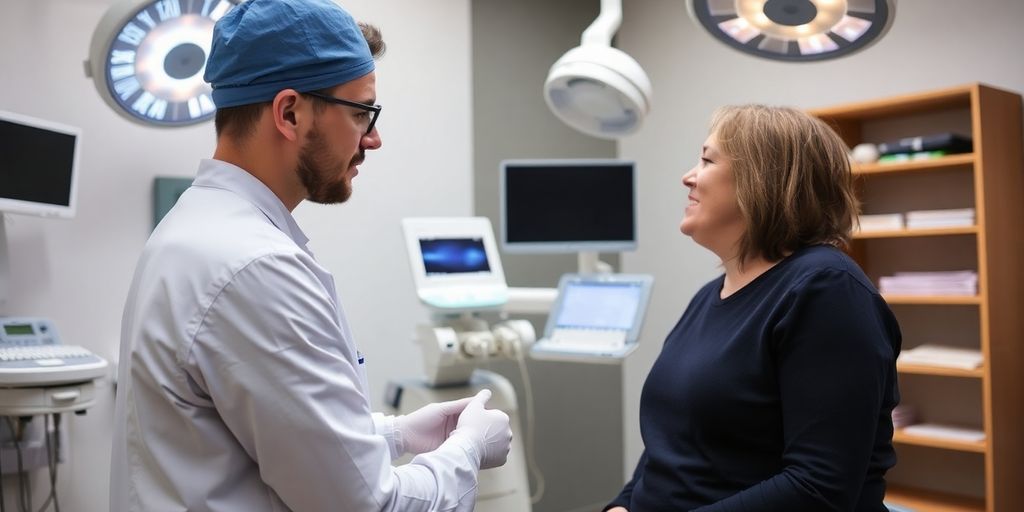SEO, or Search Engine Optimization, might sound like a techy buzzword, but for craniofacial surgeons, it’s a game-changer. In a field where expertise is crucial, getting the word out to potential patients can be tough. That’s where SEO steps in. It’s all about making sure your practice shows up when someone searches for craniofacial surgery online. This article breaks down what SEO means for craniofacial surgeons and how it can help grow your practice. From creating engaging content to optimizing for local search, we’ve got you covered.
Key Takeaways
- SEO helps craniofacial surgeons connect with more patients by improving online visibility.
- Creating quality content, like patient stories and informative articles, is essential.
- Local SEO ensures your practice appears in searches from nearby potential patients.
- Social media can be a powerful tool to engage with your audience and share success stories.
- Regularly updating and analyzing your SEO strategy is key to staying ahead.
Understanding SEO for Craniofacial Surgeons
Defining SEO in the Medical Field
Alright, let’s break it down. SEO, or Search Engine Optimization, is all about making sure your website pops up when someone searches for something related to your field. For craniofacial surgeons, this means when someone types in "craniofacial surgeon near me," your practice should be right up there in the search results. It’s like being the first name in the phone book, but for the digital age.
Importance of SEO for Medical Practices
Why does this matter? Well, think about it. When folks are looking for medical professionals, they often start online. Having a strong online presence isn’t just a fancy add-on; it’s a must-have. It helps build trust and credibility. Plus, it can bring more patients through your door. A solid SEO strategy means more visibility, and more visibility means more potential patients.
Key Components of SEO Strategy
So, what goes into a good SEO strategy? Here are a few key pieces:
- Keyword Research: Find out what terms people are using to search for services like yours. This can help tailor your content to match what potential patients are looking for.
- On-Page Optimization: This is all about making sure your website is user-friendly and contains the right keywords in the right places.
- Local SEO: Since many patients look for local services, optimizing for local search is essential. This includes things like getting listed on Google My Business and encouraging patient reviews.
"SEO isn’t just about tricking search engines. It’s about providing the best possible experience for your users." This mindset helps guide the creation of content that genuinely meets the needs of your audience.
SEO for craniofacial surgeons is not just a technical skill; it’s a way to connect with people who need your expertise. By focusing on these key components, you can ensure that your practice is visible and accessible to those who need it most.
Creating High-Quality Content

Types of Content to Produce
Creating content that resonates with your audience is crucial for craniofacial surgeons. High-quality content can include a variety of formats such as blog posts, detailed case studies, or even patient testimonials. Blog posts might cover topics like new surgical techniques, recovery tips, or advancements in craniofacial surgery. Case studies can provide an in-depth look at specific procedures and their outcomes, helping potential patients understand what to expect. Patient testimonials are particularly powerful, as they offer real-world insights into the patient experience.
Engaging Patient Testimonials
Patient testimonials can be a goldmine for building trust and credibility. They give potential patients a glimpse into the experiences of others, which can be incredibly reassuring. When crafting these testimonials, focus on the patient’s journey, from the initial consultation to the final results. Include quotes that highlight the patient’s satisfaction and the positive impact of the surgery on their life. This not only humanizes your practice but also encourages new patients to reach out.
Staying Updated with Trends
In the ever-evolving field of craniofacial surgery, staying updated with the latest trends is essential. This means not only keeping up with medical advancements but also understanding what content formats are currently engaging audiences. Consider subscribing to medical journals or attending conferences to stay informed. Additionally, regularly update your content to reflect the latest information and techniques. This ensures your practice remains relevant and authoritative in the eyes of both search engines and potential patients.
Optimizing for Local Search
Importance of Local SEO
For craniofacial surgeons, local SEO is a game-changer. Local SEO helps your practice show up when someone nearby searches for a surgeon. It’s like putting a big, bright sign on the internet saying, "Hey, we’re right here!" Patients often look for specialists close to home, so if your practice isn’t optimized locally, you might be missing out.
Google My Business for Surgeons
Setting up a Google My Business profile is a must. It’s free and easy. Fill out your profile completely—include your address, phone number, and office hours. Add some photos of your practice to give potential patients a feel for the place. This profile is often the first thing people see when they search for you, so make it count.
Encouraging Patient Reviews
Patient reviews are super important. They build trust. Ask your happy patients to leave a review. Most folks are willing if you just remind them. Positive reviews can boost your ranking in local searches, making you more visible to people looking for your services.
"The key to local SEO is consistency. Keep your information current across all platforms and encourage feedback from your patients. This helps maintain a strong local presence and attracts new patients to your practice."
Leveraging Social Media for Engagement
Choosing the Right Platforms
When it comes to social media, not all platforms are created equal, especially for craniofacial surgeons. It’s crucial to pick the platforms where your audience spends most of their time. For many medical practices, Facebook and Instagram are popular choices due to their visual nature. LinkedIn can also be valuable for networking with other professionals. Consider where your potential patients are likely to look for information and engage with them there.
Content Sharing Strategies
Sharing content isn’t just about posting regularly; it’s about crafting messages that resonate with your audience. Here’s a quick rundown:
- Educational Posts: Share insights about craniofacial procedures, recovery tips, or general health advice.
- Patient Stories: Highlight success stories with permission, showcasing before-and-after transformations.
- Live Q&A Sessions: Engage directly with your audience by answering their questions in real-time.
These strategies not only educate but also build trust with your audience, encouraging them to consider your services.
Building a Community Online
Creating a sense of community online can be a game-changer for your practice. Engage with your followers by responding to comments and messages promptly. Encourage discussions by asking questions or seeking opinions on relevant topics. This interaction fosters a supportive environment where potential patients feel valued and heard.
Building an online community isn’t just about marketing; it’s about connecting with people on a human level, making them feel part of something bigger.
Incorporating these strategies into your social media efforts will not only enhance engagement but also drive more traffic to your practice’s website.
Utilizing Visual Content Effectively
Showcasing Before-and-After Results
For craniofacial surgeons, visuals are a powerful tool. Before-and-after photos are not just about aesthetics; they tell a story of transformation and skill. Patients want to see real results before they commit to a procedure. Make sure these images are high-quality and organized by procedure type. This helps potential patients easily find what they’re interested in. Always get consent from patients to use their photos and respect their privacy.
Creating Informative Videos
Videos can be a game-changer in engaging with potential patients. They provide a dynamic way to explain procedures, show your practice in action, and feature patient testimonials. When making videos, focus on clear, simple explanations. Avoid medical jargon that might confuse viewers. It’s also helpful to include subtitles for better accessibility. Regularly updating your video content keeps your audience engaged and informed.
Using Infographics for Education
Infographics are a fantastic way to break down complex information into digestible visuals. Infographics can illustrate the steps of a procedure, compare treatment options, or highlight statistics about craniofacial conditions. They are easy to share on social media and can drive traffic back to your website. When designing infographics, keep them simple and focused. Use colors and fonts that align with your brand to maintain a professional look.
Visual content not only attracts attention but also builds trust by providing tangible evidence of a surgeon’s expertise. In a world where "seeing is believing," these tools can set your practice apart.
Implementing Email Marketing Strategies

Building an Email List
Getting started with email marketing means first building a solid email list. You can do this by offering something valuable in exchange for a visitor’s email address. This could be a newsletter filled with tips on craniofacial health or exclusive discounts on consultations. The key is to provide something your audience finds worthwhile. Here are some ideas to help you grow your list:
- Offer a free guide or e-book related to craniofacial surgery.
- Run a limited-time promotion or discount for subscribers.
- Host a webinar on a relevant topic and require registration.
Crafting Engaging Newsletters
Once you have your list, the next step is to keep your audience engaged. Crafting newsletters that are not only informative but also engaging is crucial. Think about including:
- Updates on the latest advancements in craniofacial surgery.
- Patient success stories that highlight your expertise.
- Upcoming events or workshops that might interest your subscribers.
Remember, the goal is to keep your emails relevant and interesting so your subscribers look forward to receiving them.
Promoting Special Offers
Email marketing is a great way to promote special offers directly to your patients. Whether it’s a seasonal discount or a new service, emails can help you reach your audience quickly. Consider these tips:
- Use clear and compelling subject lines to grab attention.
- Highlight the benefits of the offer in the email body.
- Include a clear call-to-action, making it easy for recipients to take advantage of the offer.
Email marketing isn’t just about sending messages; it’s about building a relationship with your patients. By consistently providing value, you can keep your practice at the forefront of their minds.
Monitoring and Analyzing SEO Performance
Using SEO Tools for Tracking
Keeping an eye on your SEO performance is like checking the pulse of your online presence. SEO tools are indispensable for tracking how well your craniofacial surgery practice is doing in search engines. Tools like Google Analytics can give you a detailed look at your organic traffic and keyword rankings. You can see which pages attract visitors and which ones need a bit more love. Regularly checking these metrics helps you understand the effectiveness of your SEO strategy and adjust it as needed.
Understanding SERP Analysis
When it comes to understanding how your practice appears in search results, SERP analysis is key. This involves looking at search engine results pages to see how your site stacks up against competitors. With a SERP Checker, you can analyze the layout of these pages and see where your practice stands. Are there featured snippets or local packs that you could target? Knowing this can help you tweak your content to better align with what search engines prioritize.
Adjusting Strategies Based on Data
Data is your best friend when it comes to refining your SEO strategy. Once you’ve gathered insights from your SEO tools and SERP analysis, it’s time to make some changes. Maybe a certain keyword isn’t performing as expected, or perhaps your patient conversion rates are lower than you’d like. Use this information to tweak your approach—whether that’s by updating content, optimizing for different keywords, or improving site speed. Staying flexible and responsive to data will help keep your SEO efforts on track.
By constantly monitoring and analyzing your SEO performance, you can stay ahead of the game and ensure your practice remains visible and competitive in the digital landscape.
Conclusion
So, there you have it. SEO isn’t just for tech companies or retail giants; it’s a game-changer for craniofacial surgeons too. By getting your practice noticed online, you’re not just boosting your patient numbers—you’re building trust and credibility in a field where those things really matter. Whether it’s through crafting engaging content, optimizing for local searches, or making the most of social media, these strategies can help you connect with more patients who need your expertise. It’s a bit of work, sure, but the payoff? Totally worth it. Dive into the world of SEO and watch your practice grow.
Frequently Asked Questions
What is SEO and why is it important for craniofacial surgeons?
SEO stands for Search Engine Optimization. It’s a way to make your website show up higher in search results. For craniofacial surgeons, this means more people can find your practice online, leading to more patients and better visibility.
How can high-quality content help my practice?
Creating good content like blog posts and patient stories can attract people to your website. It helps show your expertise and keeps visitors interested, encouraging them to come back or share your site with others.
Why should I focus on local SEO?
Local SEO helps your practice show up in searches by people nearby. By using local keywords and getting reviews, you can attract more local patients who are searching for your services.
How does social media benefit my practice?
Social media is a great way to connect with people and share information about your practice. By posting updates and engaging with your audience, you can drive more traffic to your website and build a community.
What role do visuals play in promoting my services?
Visuals like before-and-after photos and videos can show the success of your surgeries. They catch people’s attention and are often shared, helping to spread the word about your services.
How can email marketing boost my practice’s growth?
Email marketing keeps your audience informed about new services, events, and promotions. By sending regular updates, you can encourage people to visit your website and stay connected to your practice.






